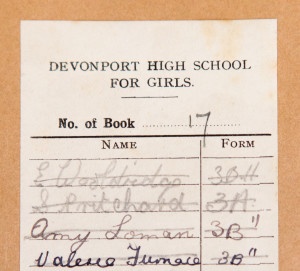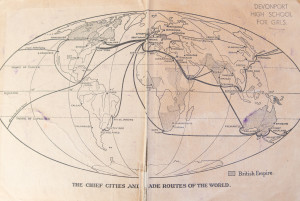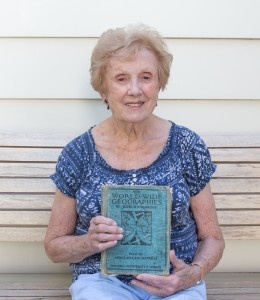Sometimes the retrieval of a lost personal effect can transport the memory across seas, decades, even wars. Such was the kind of effect my grandmother, Valerie Skaanning, unexpectedly received at her Connecticut residence, sometime around 1990.1 The package in the mail was from her hometown of Plymouth, England, and it had been sent by her older brother, Roy Furnace. Inside she found a well-worn book of world geography and a letter from her brother.

As the letter explained, Roy and his wife Margaret had recently gone to a used book fair in Plymouth, where they had enjoyed browsing through many old titles. At the fair, Roy had found the geography book, which caught his attention because it bore the stamp of his sister’s old high school: Devonport High School for Girls. This discovery prompted him to check the sign-out card inside the book, where he was amazed to find his sister’s name written in her impeccable cursive—Valerie Furnace. Ecstatic, he bought the book and sent it to her as a gift.
Upon receiving it, my grandmother was thoroughly surprised and delighted, never having thought it possible to reclaim such a book. After all, Devonport High School had been badly damaged by the Blitz bombings of World War II, making it nothing short of miraculous that this book had even survived, never mind been rediscovered by family.2 Besides that, there were the improbabilities of time and place—my grandmother had borrowed the book in her third year of high school, sometime in the academic year of 1940-1941, and then left England to spend the next 50 years of her adult life in America.3 But the sudden receding of all those distances through this reclaimed relic brought her great joy and a resurgence of childhood memories.
The book, The World-Wide Geographies, Book VI by Jasper H. Stembridge, is itself quite a lesson in history. This particular volume in Mr. Stembridge’s geography series covered Africa, Asia, and Australia, the continents my grandmother was studying in school at the time. The book was published by Oxford University Press in 1932, and my grandmother’s copy, although faded and missing a few pages, has weathered its library circulation, aerial bombings, and eighty years remarkably well. A product of its place and time, the book’s world map labels Canada, South Africa, India, Australia, New Zealand, and several other countries as part of the British Empire.4 Although my grandmother was reading this book only about a decade after its publication, its map of British territories was already inaccurate, and would only grow more outdated during World War II and its aftermath.

Among many other memories, this recovered book reminded my grandmother of the school hymn at Devonport, which she could only faintly remember. Eventually, she was able to track down the song with the help of an English friend, and she now keeps a folded copy of the lyrics to that song, entitled “To Be a Pilgrim,” inside The World-Wide Geographies as a closely related memento of her high school years.
As it turns out, this song is the only hymn attributed to John Bunyan, found in Part II of The Pilgrim’s Progress.5 The version my grandmother sang, however, and the one she keeps in the geography book, was the one modified by Percy Dearmer6, which begins,
He who would valiant be ‘gainst all disaster,
let him in constancy follow the Master.
There’s no discouragement shall make him once relent
his first avowed intent to be a pilgrim.7
Since its publication, this version of the hymn has gone by many names, including “To Be a Pilgrim,” “He Who Would Valiant Be,” and “Who Would True Valor See.”
The finding of this hymn was even dearer to my grandmother than the geography book, since the song’s theme binds together three strands of her life—her schooling, her voyage to America, and her faith. Although she sang “To Be a Pilgrim” throughout her war-torn high school years at Devonport, she never felt more like the pilgrim of the song than in February of 1946, when she
stood on the docks to board the Queen Mary.8 There she was, one of 1,700 World War II brides bound for America, and she thought of the song as the mayor of Southampton bid her and all the other brides farewell as “the pilgrims of ‘46.”9 Later, in America, she became a born-again Christian at a Billy Graham Crusade in Boston, at which point the theme of Bunyan’s hymn took on an even greater meaning for her.10

Now, seventy years after boarding the Queen Mary, my grandmother, 89, holds this book and Bunyan’s hymn as dearly as ever. Both are markers of where she has been and what she has been and how miraculous the journey has been. To think that these two items followed her across the Atlantic 50 years later still amazes her, as it amazes me. It’s a tale of persistence and grace, like the final verse of “To Be a Pilgrim”:
Since, Lord, thou dost defend us with thy Spirit,
we know we at the end shall life inherit.
Then, fancies, flee away! I’ll fear not what men say,
I’ll labor night and day to be a pilgrim.11
References
1.Valerie Skaanning, in discussion with the author, August 2016.
2. Ibid.
3. Ibid.
4. Jasper H. Stembridge, The World-Wide Geographies, Book VI (London, England: Oxford University Press, 1932), inside cover.
5. Christopher Howse, “Sacred Mysteries: The man who rewrote Bunyan,” The Telegraph, April 23, 2013, accessed August 19, 2016, http://www.telegraph.co.uk/news/religion/10005866/Sacred-Mysteries-The-man-who-rewrote-Bunyan.html.
6. “He who would valiant be,” org, 2007, accessed August 19, 2016, http://www.hymnary.org/text/he_who_would_valiant_be.
7. Ibid.
8. Valerie Skaanning, in discussion with the author, August 2016.
9. Ibid.
10. Ibid.
11. “He who would valiant be.”
Benjamin Chase
Contributor
